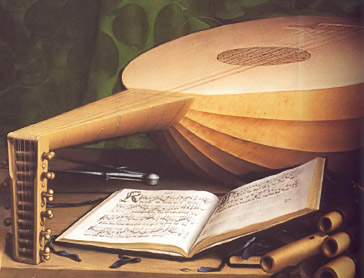
LUTE CAMERATA
LEVEL ONE
home
Level one: A good sound. Know what they knew, and practice. Tuning. Simple pieces, basic technique. Beginning notation. Throw away your solo CDs.
Level two: books of songs; simple scores, two clefs. Jack & Joan. Simple pieces and songs from both Tab and keyboard notation. The grand rotation.
Level three: musicianship.
Jack & Joan
Level Four: The art of accompanying. Ensemble skills. Medium to high difficulty part songs.
Level five: the great solos and real renaissance ornaments; complex scores, clefs. Different Tab versions, singing from TAB. Arranging. The art of orchestra playing. Advanced rhythms such as late 14th century music and pieces by Tye and Baldwin.
Level Six: True professional, thorough knowledge of the middle ages, renaissance and baroque. All clefs. Al scores. All solos. All songs.
|
|
If you have progressed this far, you now have a decision to make. Simply put, are you a surfer or a serious musican? To be a serious musician, you must take the study of music seriously, and that means lessons and training. Any good music school or conservatory requires years of musicianship, score reading and keyboard for just a basic degree. As a musician, these highly trained people are your colleagues and your competition. There is right now no one stop shopping for training in both musicianship and historical performance, so you will need several teachers, despite what anyone may tell you. Right away, you will be able to tell who has your best interests at heart. A good teacher will encourage you to divide your studies. A teacher who looks at students as a source of income will try to convince you that it is unnecessary. Let's first start by contemplating the fact that the the study of the art of music is one of the most rewarding things one can do. Let's see where we are, where we need to go, how to do it, and, finally, how we might measure up to a renaissance musician. Remember, music is fun. We start with a frank assessment of the state of the lute in regard to musicianship. Currently, if we consider singers, recorder players, viol, sackbut, shawm, cornetto, curtal, and so on, it is immediately apparent that lute players are at the bottom of the pile. If you think that all the other players are not making jokes about the sight reading skills of the lute players, sorry, time for a new bubble. In contrast, in the renaissance, lute players were among the most highly trained and highly regarded musicians. The reason for this is simple. Lute players are smart, and reasonably hard working, they just lack basic training in musicianship. On the other hand, if you only study what you want, play what you want, and do what you want, that is just self-indulgent and lazy. Unfortunately, teachers let students get away with bad practice habits. As a professional, if you have limited musicianship skills, you will never reach your full potential. As an amateur, you will eventually burn out on surfing. As a workshop participant, in a mixed ensemble, you will be put in a lower level class. Let's think about this situation positively: this is a tremendous opportunity for players who have the desire to really change things for the better. All it takes is some lessons. Let's take a step back and think agin what the elements of musical training are for a renaissance musician are. First, singing. It is certain that in the renaissance, if you could not sing a one-on-a-part madrigal, you were a disaster. So, your first order of training must be sight-singing, ideally with some basic voice lessons. If you can't sing, you can't play renaissance music. In my classes, I teach renaissance sight-singing, using the moveable hexachord. Although there are a few people who teach this, your chances are slim, so you will have to learn modern sight-singing, and pick up the hexachord on your own or at workshops that teach original notation. Next, you need a thorough grounding in rhythm. Musical rhythm is very different from TAB rhythm, you need to know both. When the time comes to play an opera, it won't be in TAB. Ideally, you should know original notation, such as they teach at the Basel Conservatorium, but it is not required. Get a hold of a copy of Hindemith's Elementary Training for Musicians, and start to work through it. You will need a teacher. Not a lute teacher, a music teacher. As a music student many years ago, one of the things we often talked about was hanging out with the people who could really play, so some of the musicianship would "rub off" on us. In fact this is exactly what happens, for better or worse. You need to be around good musicians.
Sight-singing was level one for for the Elizabethans; for us it is level three. If you can sight sing a part in a madrigal, have a musicianship teacher and can stagger through the first third of Hindemith's book, have started buidling your resume, and have found some professional players of all kinds to play with, you are ready for level four. Don't forget to practice every day. |